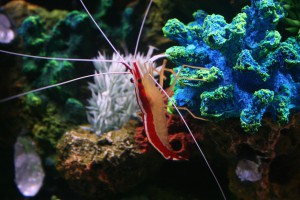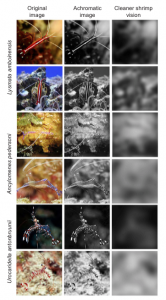It’s easy to look at the bright colors on the cleaner shrimp Lysmata amboinensis (pictured below) and assume that it appears that way to its fellow shrimp. But shrimp eyes do not work the same as ours, and research suggests that these helpful arthropods might not be able to see each other in all their glory.
Cleaner shrimp gather in pairs or groups at “cleaning stations” to attract fish clients. The shrimp clean parasites from the outside of these fish, getting a free meal in the process. The shrimp have to be able to recognize each other and their client fish in order to team up and clean, but there is evidence that their colors and patterns are lost on each other.
Researchers interested in how the visual systems in these shrimp work conducted experiments to find out what colors the shrimp can see, and how finely they can resolve patterns.
To test color vision, the researchers measured the electrical responses of the shrimps’ eyes when exposed to different colors of light, ranging from red to ultraviolet. If the eyes responded to a certain color of light, it can be assumed that the shrimp can perceive that color. To determine the limits of their spatial resolution, the researchers put the shrimp in a rotating drum covered with lines of varying width. If the shrimp could discern the separate lines, they would rotate their bodies to match the rotating drum.
The researchers found that the shrimp could generally only see one color of light (green) and that they had fairly coarse spatial resolution. The image below depicts how the shrimp would see each other.
This means that the shrimp are essentially colorblind, and not good at discerning detailed patterns.
The implications are that these shrimp probably evolved their bright coloration for reasons other than seeing each other- possibly as camouflage, or to make it easier for client fish to find them. Furthermore, the shrimp must be using cues other than vision (touch or smell, for example) to recognize each other, their client fish, and the parasites they want to eat.
This study is an important example of how important it is to consider the visual system of a study organism: the way we see them is not necessarily how they see each other.
Reference:


